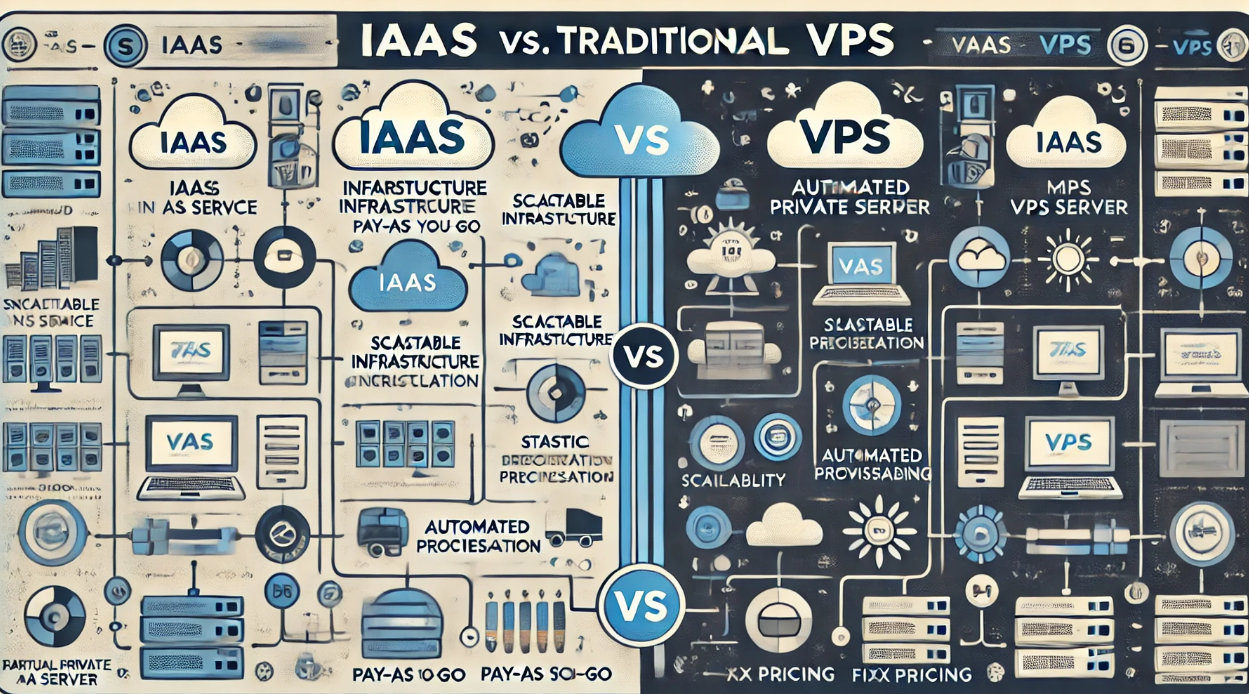Top 10 Benefits of Switching to IaaS for Your Business
Why SMBs are moving beyond traditional hosting in 2025
Introduction
As small and mid-sized businesses grow, so do their infrastructure needs. Many are discovering that traditional hosting solutions—like shared hosting or basic VPS—just don’t cut it anymore. That’s where Infrastructure as a Service (IaaS) comes in.
IaaS gives your business enterprise-grade infrastructure without the enterprise costs, offering flexibility, security, and control like never before.
In this post, we’ll break down the top 10 benefits of switching to IaaS, and help you understand whether it’s time to move away from traditional VPS hosting.
✅ 1. Lower Upfront Costs
Traditional hosting often requires investment in hardware, licenses, and on-site IT staff. With IaaS, all of that is handled by your provider.
Why it matters:
-
Pay only for what you use
-
No hardware depreciation
-
Great for startups and growing teams
Example: A small agency can spin up new servers as needed, without buying and maintaining physical machines.
2. Rapid Scalability
IaaS platforms let you scale resources—CPU, memory, bandwidth—on-demand.
Why it’s a game-changer:
-
Handle traffic spikes effortlessly
-
Add or remove servers with a few clicks
-
Perfect for businesses with seasonal demand
Example: An eCommerce store can increase capacity during holiday sales, then scale back after.
3. Built-In Disaster Recovery & Backups
Data loss can be devastating. IaaS providers offer automated backups and geographic redundancy, reducing downtime and recovery time.
Benefits:
-
Daily or real-time backups
-
Disaster recovery as a service (DRaaS)
-
Peace of mind for business continuity
Example: If your main server goes down, IaaS reroutes traffic to a backup instance in seconds.
️ 4. Simplified Infrastructure Management
With IaaS, you don’t manage physical servers—you manage virtual infrastructure through an intuitive dashboard or API.
For SMBs:
-
No need for a full-time IT admin
-
Infrastructure-as-Code (IaC) enables automation
-
Focus on growing your business, not maintaining hardware
Example: Use Terraform or Ansible to automate server provisioning with minimal effort.
5. Improved Network Performance
IaaS platforms are built on optimized, low-latency data centers connected globally.
Benefits:
-
Content Delivery Network (CDN) support
-
Load balancing
-
Higher uptime SLAs (Service Level Agreements)
Example: Your app runs faster for users worldwide thanks to edge computing nodes.
6. Full Customization & Control
Traditional VPS hosting often limits you to pre-configured plans. IaaS gives you root access, OS selection, and complete environment control.
Ideal for:
-
Developers, SaaS startups, tech consultants
-
Businesses running custom or legacy apps
Example: Choose Ubuntu, CentOS, or Windows Server—then configure it exactly how you need.
7. Enhanced Security Options
IaaS lets you implement custom firewalls, private networks, role-based access, and more.
️ Security Features Include:
-
DDoS protection
-
Encrypted storage volumes
-
VPN and dedicated IP support
Example: Isolate your sensitive workloads in a private subnet while maintaining public-facing apps separately.
8. Predictable, Pay-As-You-Go Pricing
Unlike fixed hosting plans, IaaS uses usage-based billing. You pay for the exact resources you consume.
This means:
-
No overspending on unused capacity
-
Clear forecasting for infrastructure costs
-
Easy budget control for finance teams
Example: Pause underused instances overnight to cut monthly costs.
9. Seamless Integration with DevOps Tools
IaaS platforms are designed for modern workflows, supporting DevOps tools out of the box.
⚙️ Integrations include:
-
CI/CD tools like Jenkins, GitHub Actions
-
Monitoring tools like Grafana and Prometheus
-
IaC with Terraform, Ansible, and Pulumi
Example: Automate testing and deployments with infrastructure that adapts to your pipeline.
10. Global Reach & Reliability
Need infrastructure in Europe, Asia, or the U.S.? IaaS gives you instant access to global regions, all backed by powerful SLAs.
You’ll Get:
-
Reduced latency for international users
-
Compliance with local data regulations
-
Redundant backups across continents
Example: A startup in Canada can deploy infrastructure in Singapore in minutes.
3. IaaS vs Traditional VPS Hosting: Which One is Right for You?
| Feature | Traditional VPS | IaaS |
|---|---|---|
| Scalability | Limited | Instant & flexible |
| Customization | Somewhat limited | Fully customizable |
| Automation | Manual setups | Infrastructure-as-Code |
| Pricing | Fixed | Pay-as-you-go |
| Redundancy & Backup | Varies by provider | Built-in options |
| Global Deployment | Limited | Multi-region available |
| Security Control | Shared | Granular control & isolation |
✅ Choose IaaS if you:
-
Want more control, scalability, and cost-efficiency
-
Plan to grow, pivot, or scale quickly
-
Need DevOps-ready infrastructure with API access
❌ Stick with VPS if you:
-
Only run a single website or blog
-
Don’t require much scalability
-
Prefer a “set it and forget it” solution with minimal tech involvement
Final Thoughts
Switching to IaaS is one of the smartest moves SMBs can make in 2025. It’s more agile, affordable, and future-proof than traditional hosting.
Whether you’re running multiple client sites, launching SaaS products, or managing an app with global users, IaaS empowers you to scale smarter—not harder.

